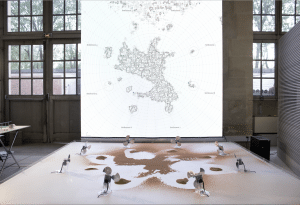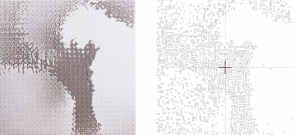At the occasion of the first edition of the Biennale de l’architecture et du paysage taking place in Versailles (France) from May 4th to July 13th 2019, IAAC and APPAREIL are showcasing Programming the Perpetual Unknown, a project aiming to stimulate reflection on the role of geology and the ways we have had to inhabit it. Geological conditions, resources and forms have shaped the development of our territorial organization and the way we inhabit the world. But this is a two-sided relationship as geology also ends up impacted by humankind’s behaviours and ways to inhabit it.
At the very heart of current geology-related-issues, Programming the Perpetual Unknown is an automated and dynamic installation depicting the reciprocal relationship between geology and human living conditions. As a two-fold fiction, this installation shows sand formations mutating and a dynamic architectural drawing reacting – and, finally, affecting it. The two entities – the changing geology on the horizontal table and the dynamic drawing projected on the vertical wall – are translations of each other. For instance, when a sand dune is moved, the drawing reacts by re-organizing a settlement around it. Conversely, if some space is too densely inhabited on the drawing, it is the drawing that affects the geology in return by modifying the sand landscape on the plateau.
Staging an electronic environment and a dynamic in which elements are set in motion in an automated performance, Programming the Perpetual Unknown is a game with open interpretations. The movement is perpetual and the outcome is unknown, all governed by a protocol of actions in which the speed of revolution of a fan in a physical environment could be affected by the density of a built settlement drawn in a digital space…
Climate change, contamination, social relations, real estate development, etc… humankind’s ways of inhabiting territories have evolved and geology is experiencing their backlash. People have started to realize that geology cannot be taken for granted, as what is here today may not be here tomorrow. These new forces have to be taken into account, as humankind’s relation to geology needs to evolve. If the city of tomorrow will adapt faster to geological conditions, its impact must be considered. Programming the Perpetual Unknown stands for a sort of laboratory for all these mandatory questions and reflections.



